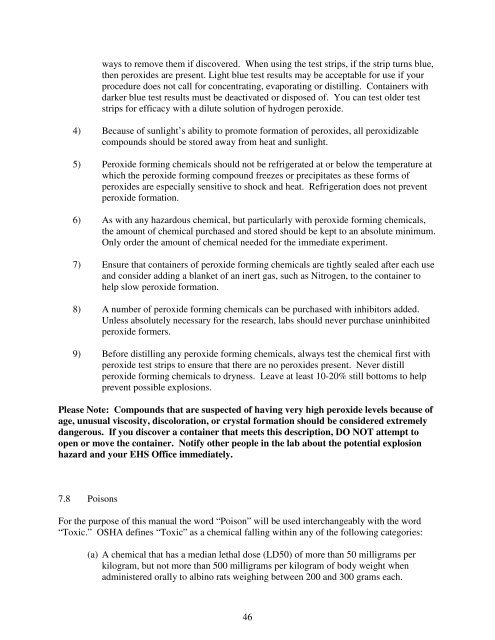Chemical Hygiene Plan - Queensborough Community College ...
Chemical Hygiene Plan - Queensborough Community College ...
Chemical Hygiene Plan - Queensborough Community College ...
Create successful ePaper yourself
Turn your PDF publications into a flip-book with our unique Google optimized e-Paper software.
ways to remove them if discovered. When using the test strips, if the strip turns blue,<br />
then peroxides are present. Light blue test results may be acceptable for use if your<br />
procedure does not call for concentrating, evaporating or distilling. Containers with<br />
darker blue test results must be deactivated or disposed of. You can test older test<br />
strips for efficacy with a dilute solution of hydrogen peroxide.<br />
4) Because of sunlight’s ability to promote formation of peroxides, all peroxidizable<br />
compounds should be stored away from heat and sunlight.<br />
5) Peroxide forming chemicals should not be refrigerated at or below the temperature at<br />
which the peroxide forming compound freezes or precipitates as these forms of<br />
peroxides are especially sensitive to shock and heat. Refrigeration does not prevent<br />
peroxide formation.<br />
6) As with any hazardous chemical, but particularly with peroxide forming chemicals,<br />
the amount of chemical purchased and stored should be kept to an absolute minimum.<br />
Only order the amount of chemical needed for the immediate experiment.<br />
7) Ensure that containers of peroxide forming chemicals are tightly sealed after each use<br />
and consider adding a blanket of an inert gas, such as Nitrogen, to the container to<br />
help slow peroxide formation.<br />
8) A number of peroxide forming chemicals can be purchased with inhibitors added.<br />
Unless absolutely necessary for the research, labs should never purchase uninhibited<br />
peroxide formers.<br />
9) Before distilling any peroxide forming chemicals, always test the chemical first with<br />
peroxide test strips to ensure that there are no peroxides present. Never distill<br />
peroxide forming chemicals to dryness. Leave at least 10-20% still bottoms to help<br />
prevent possible explosions.<br />
Please Note: Compounds that are suspected of having very high peroxide levels because of<br />
age, unusual viscosity, discoloration, or crystal formation should be considered extremely<br />
dangerous. If you discover a container that meets this description, DO NOT attempt to<br />
open or move the container. Notify other people in the lab about the potential explosion<br />
hazard and your EHS Office immediately.<br />
7.8 Poisons<br />
For the purpose of this manual the word “Poison” will be used interchangeably with the word<br />
“Toxic.” OSHA defines “Toxic” as a chemical falling within any of the following categories:<br />
(a) A chemical that has a median lethal dose (LD50) of more than 50 milligrams per<br />
kilogram, but not more than 500 milligrams per kilogram of body weight when<br />
administered orally to albino rats weighing between 200 and 300 grams each.<br />
46
















